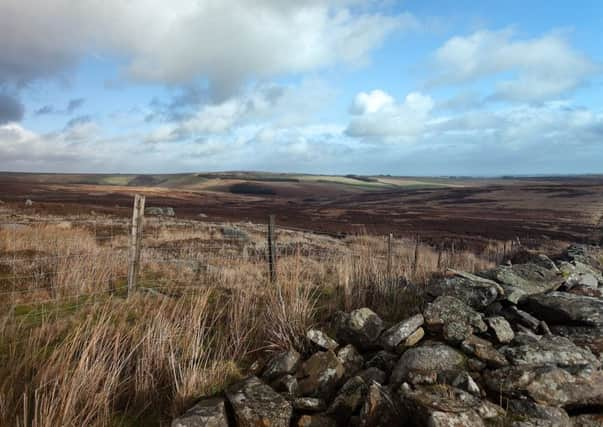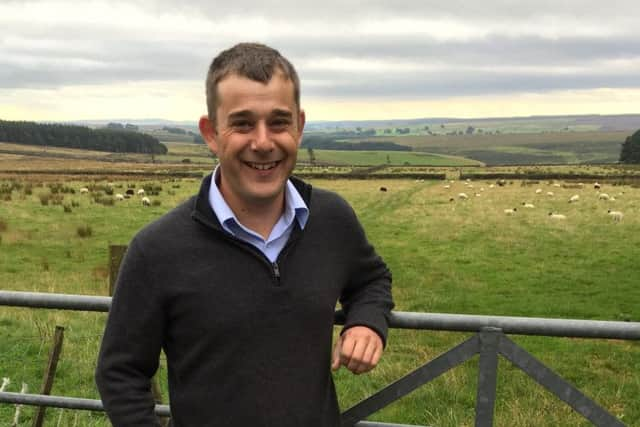Helping Yorkshire farmers to harvest a greener world


Farmhouse kitchens are built for crowds. There is always plenty of space and big tables to accommodate workers refuelling after heavy sessions out on the land.
A bright late August day found me in one such kitchen at Humberstone Bank Farm near Blubberhouses, set amidst the stunning moorland scenery of Upper Nidderdale in North Yorkshire.
Advertisement
Hide AdAdvertisement
Hide AdAt the head of the table, fittingly, was newly installed farmer Jonathan Grayshon.


He is not your typical upland farmer. Firstly, because of his age: Grayshon is 28, in an industry where the average age is 58 and climbing.
“As any young person, I am quite ambitious,” says Grayshon.
“Sometimes my partner Sarah will just say: ‘Ah, you’re just a farmer’. And I’ll say: ‘No, I am not just a farmer – farmer is a bit of what I do, but there is a lot more to this farm than just farming’. I am hoping it could develop into something else.”
Advertisement
Hide AdAdvertisement
Hide AdThat is the second thing that makes Grayshon different: At a time of Brexit and seismic change for farming and agriculture, he sees the changing role of the farmer, for traditional farming to become ‘just a bit of what he does’, as an opportunity rather than a threat.


Given that Humberstone Bank is an experimental farm, a ‘farm for the future’, Grayshon has found himself in the right place at the right time. He has found his niche.
Around the farmhouse table with me are landworkers of a different kind. Lisa Harrowsmith, a lead surveyor, and Andrew Walker, a catchment strategy manager. Both are with Yorkshire Water, which owns the farm and surrounding land.
When the previous tenancy came to an end (a farming family who had been in place for 80 years) Yorkshire Water decided to develop Humberstone Bank Farm as a flagship for their ‘Beyond Nature’ vision, to develop a new way of managing the uplands which optimises and gives equal weight to water quality, biodiversity, healthy peat boglands, farming, and grouse shooting.
Advertisement
Hide AdAdvertisement
Hide Ad“A lot of what we are doing here complements the water quality,” says Harrowsmith.
“That is the number one reason why we own land, because we can put in restrictions and have that extra bit of control on the land management so we can protect the water going into the reservoirs.
“The cleaner the water once it gets to the treatment works, the less chemicals are required to treat it, and the less power and energy is used. So it all fits together.”
Earlier in the day Grayshon had been showing me round the farm.
Advertisement
Hide AdAdvertisement
Hide AdWe were only a few tens of yards from the farmhouse, but already we were at the top of a rise looking down past rough grassland, over a dense patch of soft rushes, across a beck feeding Thruscross Reservoir which supplies Leeds with its water, over this beck and the heather moorland alive with purple flower, past the shooting cabin in the mid-distance, and finally to the ruins of Bolton Abbey on the horizon.
There, in that vista, in that one sweep of the eye, lie all the potential problems and opportunities when trying to create a productive landscape from these uplands.
To keep all the stakeholders happy is the Beyond Nature vision.
The sporting estate wants to produce sufficient numbers of grouse to run the shoots. The farmer wants land to graze his livestock. The water company wants to harvest water of the highest quality which requires as little treatment of possible, which minimises the environmental damage and helps to keep bills down for us, the customer.
Advertisement
Hide AdAdvertisement
Hide AdAs such, Yorkshire Water has a strong interest in how both the moor is managed, and how the farmer manages his land.
Producing grouse in high numbers has traditionally prized heather dominated moorland. But too much heather dries out the peat and adds to the erosion. However, there is a point where the amount of heather can be reduced, the peat wetted, but grouse numbers maintained.
”If we can demonstrate that this works for us for water quality, and works for the grouse moor owner, who can now see that just because we have had 150 years of 90 per cent heather cover doesn’t mean that we can’t manage it in a different way,” says Andrew Walker.
“If it works for everybody, why wouldn’t you implement it?”
The withdrawal from Europe and the Common Agricultural Policy (CAP) does offer an opportunity to change how farming in this country is funded, to acknowledge the ‘ecosystem services’ the farmers provide to the taxpayers paying for it as being equal to those as food producers.
Advertisement
Hide AdAdvertisement
Hide AdBut in reality, farmers’ funding has been moving in this direction for years now. It is just not, many farmers feel, common knowledge for the public.
Grayshon finds this frustrating. “There has been a lot of good work gone on in the last ten years in terms of the environment, the money has been there and farmers have done work for it by keeping less sheep or doing less things,” he says.
“So there is a lot of public good gone on, but I don’t think it gets fully registered by the general public.”
Perhaps Brexit offers the opportunity to make that role explicit, to simplify the funding structure so that farmers are paid to do things rather than not do things. Results based agri-environment schemes, as the jargon will have it.
Advertisement
Hide AdAdvertisement
Hide AdBut the change will be evolutionary rather than revolutionary.
Grayshon is relishing this new role, to make traditional farming ‘just a bit of what he does’.
He points to the invasive rush again. There are plans to bring in some cattle, which are heavy enough to break down the rush, allow other species to come through and provide habitat for wading birds.
”When I first started I thought it will be a case of pulling away from farming and letting the rush take over,” he says. “But the more you learn, you realise that it does need managing, and there is a case for having the grazing livestock in there as well.”
Advertisement
Hide AdAdvertisement
Hide AdA hard-nosed business case for introducing cattle in the traditional farming sense could not be made, but one for increasing biodiversity can. And increasing biodiversity can have multiple benefits one of which is helping to improve the quality of the water in the catchment, and ultimately what comes out of our tap.
The outbuildings at Humberstone Farm are in the process of being converted into a learning hub, where lessons from the farm can be shared and skills exchanged with other farmers and land managers in the area.
Back around the kitchen table I asked Grayshon about his hopes for the farm.
“I don’t think it will ever be the be all and end all, in that whatever goes on here is farming and that it is the only way forwards,” he says.
Advertisement
Hide AdAdvertisement
Hide Ad“But I hope it can shape some farms, that some people can come along and take ideas from it and roll a little bit of it into their farm, or how they manage their land.
“I think it can be one way forward and people can get some ideas from it.”
Helping farmers to help themselves
How moorlands are managed and how farmers manage their land are crucial, and the way that land is farmed is just as important for water quality.
A recent investigation by the Bureau of Investigative Journalism has revealed agriculture to be the number one polluter of our rivers now, taking over the top spots from industry and sewerage.
Advertisement
Hide AdAdvertisement
Hide AdIn the region, a big problem is sediment – topsoil running off and entering our rivers. It costs Yorkshire Water £370,000 a year to remove this sediment – the equivalent of 11 hectares of topsoil being lost each year.
As a result there is a strong incentive for Yorkshire Water to help devise and promote best practice for farming.